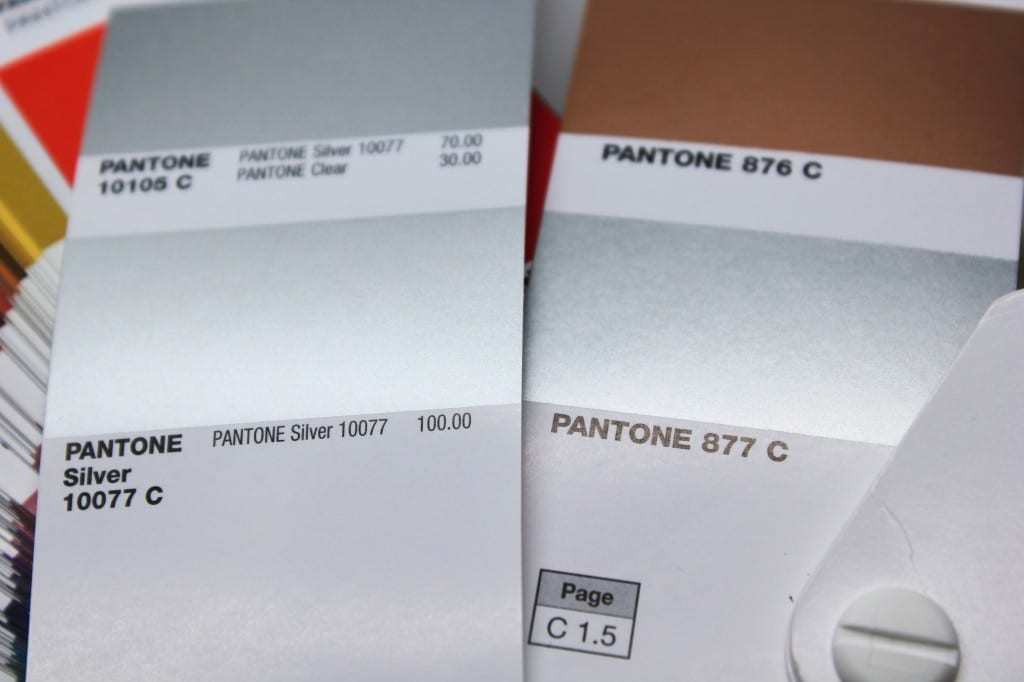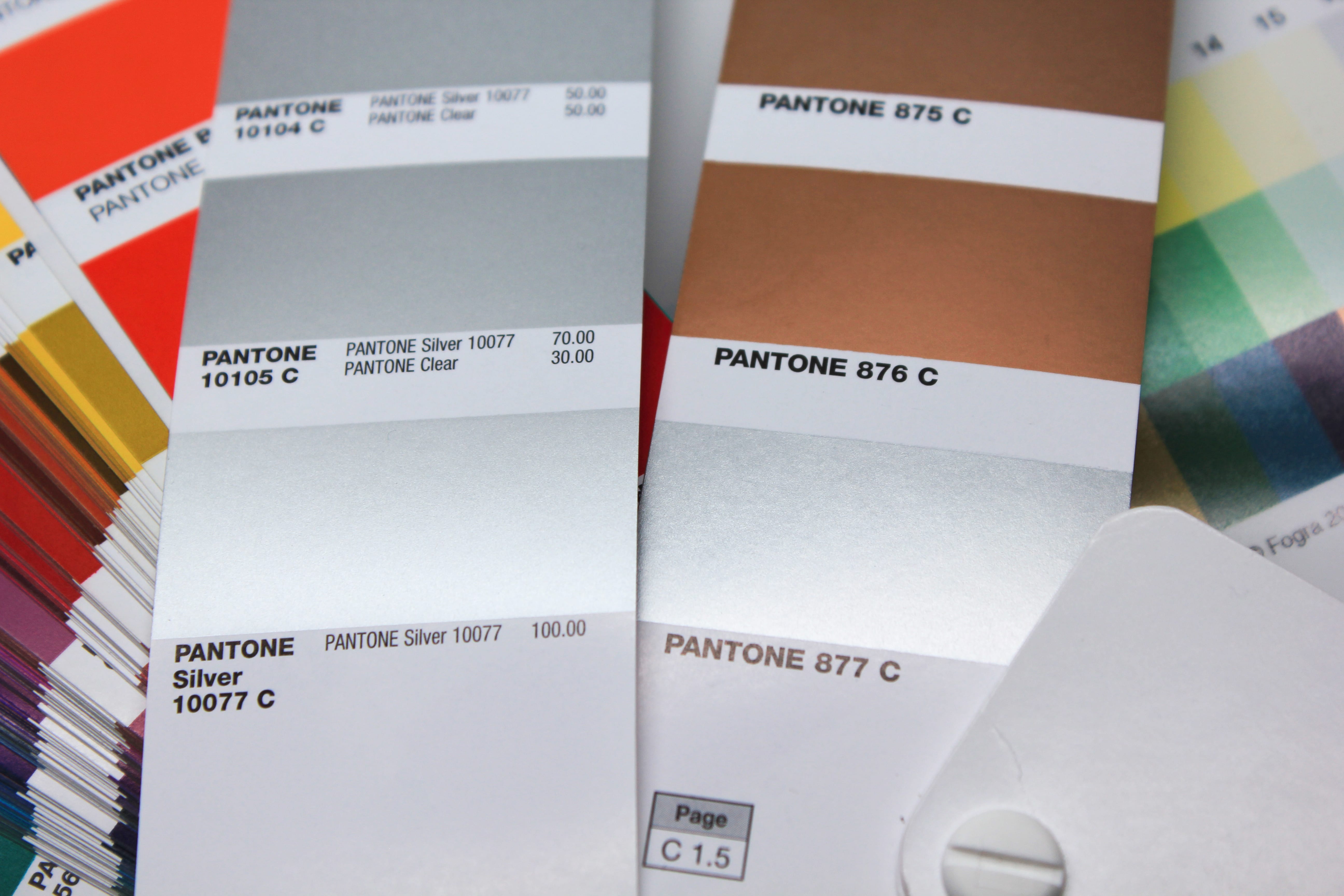Currently, PANTONE has two parallel Metallics colour fans:
- PANTONE Metallics Coated: Contains the classic metallic shades available since the late 1980s.
- Main basic colours: PANTONE 877, 876, 875 …
- Typical colour names: PANTONE 8020, 8040, 8060, etc.
- PANTONE Premium Metallics Coated: The new Metallics fan, which has been in existence since 2012, showing new, finer metallic shades.
- Main basic colour: PANTONE Silver 10077 C
- Typical colour names: PANTONE 10142, 10158, 10214, etc.
The main differences between the two fans lie in the composition of their respective basic colours: Firstly, there is the different Pantone Silver: PANTONE 877 or PANTONE Silver 10077 C. On the other hand, in the PANTONE Metallics Coated the silver is supplemented by further gold basic colours, while in the PANTONE Premium Metallics Coated the newly defined silver is the only metallic basic colour and is tinted by PANTONE Goe basic colours.
Pantone 877 and the gold inks contain metal flakes which, after the ink has dried on the paper, settle on the ink surface like leaves, creating a silver effect. This irregular surface structure can be very different and depends, among other things, on the drying time of the ink. As a result, the silver effect could vary from print to print. After varnishing, the silver effect was usually much weaker and less brilliant than before print finishing.
PANTONE Silver C(called PANTONE Silver 10077 C in the fan, but today mostly communicated by Pantone itself as PANTONE Silver C) consists of finely emulsified metal particles, which, in contrast to the metal flakes of the 877, are very evenly distributed on the paper due to the colour. The result is a more even, calm and brilliant silver surface that retains its shine and brilliance even after varnishing and is more stable in perspective than the previous colour. According to PANTONE, the durability of the ink has also been improved. The new silver is compatible with UV and water-based lacquers and can be laminated and foil embossed.
The Premium Metallics C colour fan from PANTONE shows colour reproduction with and without dispersion varnish. Important for printers: Due to the different composition, the manufacturer Eckhart recommends a different density: 1.0 for PANTONE 877 and only 0.7 for the new PANTONE Silver C, each measured with a polarized densitometer via the black filter.
One thing is not quite clear: The new 300 PANTONE Premium Metallics C colours are mixed from PANTONE Silver 10077 C and PANTONE Goe basic colours. However, GOE was discontinued in 2014. According to information from a Pantone employee, the colour shades will be converted to the 18 Pantone Matching System basic colours in a new fan generation – PANTONE Bright Orange (GOE) would then become PANTONE Orange 021 (PMS) as the basic colour. Since the basic colour is the same anyway, and has only differed in the thickness of the layer, this has no effect on the colourfulness.
Both PANTONE colour fans are stored as spot colours in our FIERY XF for the proof and can therefore be proofed as spot colours by Proof.de – in the context of the very poor proofability of metallic colours. As no metallic pigments are available for proofing, the silvery effect is only simulated by the velvety gloss of the proof paper. We use the EFI 4245 Gravure Proof Paper, which has a satin surface and allows a halfway decent silver simulation. However, a reasonable preview of the expected printing result is only possible in the PANTONE colour fan.
You can order PANTONE 877 or PANTONE Silver C Proofs here

Today I received an email in which PANTONE asked how it should orientate its products and services in the future. The users were asked which countries, industries and company sizes they come from, but also what PANTONE products should look like in the future and what customers would be prepared to pay for PANTONE services in the future. Question: How much can PANTONE services cost? PANTONE appears to be orientating itself on the PANTONE Connect prices: All price queries have the lowest price category < $ 7,- / month, i.e. … read more

This year we once again created proofs for Fogra certification and sent them to Munich-Aschheim for testing. With these proof prints, which we print according to three different proof standards and on three different papers, we point out that we not only deliver excellent proof quality through internal quality controls and checks, but that the quality of our proofs is also measured and confirmed by external experts. We have now had test prints certified by Fogra for the 12th time. We have also been “Spot-cert” certified for the display of … read more

Peter Jäger is an expert in colour management that reliably works across the boundaries of printers and monitors, web and print – essentially: cross-media.

A new generation of colour measuring devices is entering the market: in contrast to the classic measuring devices, which are available as a fully encapsulated system either as a colourimeter or as a spectrophotometer, and then supply the data to a computer via an interface or app or display it directly, the new generation of colour measuring devices consist only of lighting and software, with the optics of a modern iPhone from Apple being used as the sensor. Until now, there have been two categories of measuring devices on the … read more

From now on you can order proofs for metal decor printing on white sheet metal at proof.de: The ICC profile for Fogra60 is Metal-Printing_MPC1_FOGRA60.icc

Digimarc is a digital watermark that can be used to embed information in images, videos or other media. Digimarc watermarks are invisible to the human eye, but remain recognisable to special software or devices. Digimarc is becoming increasingly popular in the packaging sector in particular, as this technology allows the digits of the EAN barcode and more to be applied invisibly to all areas of the packaging. Digimarc and EAN barcode at the supermarket checkout When scanning at the checkout, the checkout staff do not have to search for the … read more

Whether it’s a large global corporation or a small company, the following often applies to designs or redesigns today: we develop everything for digital first.

A few days ago Proof GmbH was the first company to be certified for proofing for the new 7C exchange colour space FOGRA55. Fogra has developed characterisation data for extended multicolour printing with the printing colours CMYKOGV – i.e. cyan, magenta, yellow, black (contrast), orange, green and violet – FOGRA55 as part of a research project over the past few years. The characterisation data and the ICC profile Ref-ECG-CMYKOGV_FOGRA55_TAC300.icc have been published on the Fogra website in recent weeks. We have now carried out the certification via GMG ColorProof, as … read more

In recent weeks, there have been lengthy discussions on the Fogra digital printing mailing list as to whether a research project should be launched to define standardised tonal value gradations for spot colours. What is this all about? In the field of CMYK and seven-colour printing, the definition of clear, printable and proofable standards is well established and has been tried and tested in practice. If the paper or paper class is known and defined, a measuring standard such as M0/M1/M2 has been established and the content of optical brighteners … read more

Several errors have crept into the new PANTONE 2023 fan decks. In both the PANTONE Solid Coated and the Solid Uncoated color fans, there are colours for which the new ink formulations are incorrect. In the PANTONE Formula Guide Solid Coated fan 2023, PANTONE 107 C and PANTONE 108 C have absolutely identical ink recipes, as well as PANTONE 113 C and PANTONE 114 C. As the colors differ, this cannot be the correct. Several errors in the PANTONE Solid Uncoated fan 2023 In the PANTONE Solid Uncoated fan 2023 … read more











